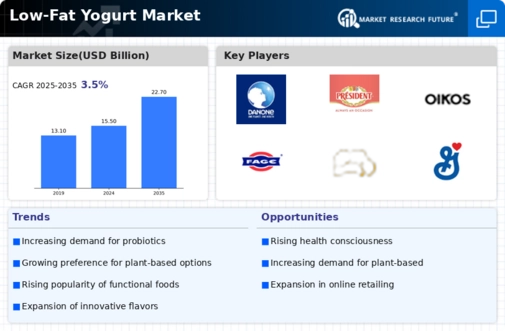Top Industry Leaders in the Low Fat Yogurt Market

The Competitive Landscape of the Low-Fat Yogurt Market is characterized by a dynamic and competitive industry where key players, both established and emerging, are strategically positioning themselves to cater to the growing consumer demand for healthier dairy options. These companies deploy various strategies to enhance product offerings, strengthen market presence, and adapt to changing consumer preferences.
Key Players:
Danone, Inc. (Canada)
General Mills, Inc. (U.S.)
Yogurtland (U.S.)
Nestle S.A. (Switzerland)
Jalna Dairy Foods Pty. Ltd. (Australia)
Byrne Dairy Inc. (U.S.)
Yasso (U.S.)
Rainy Lanes Dairy Foods Ltd (U.K)
Strategies Adopted:
The Low-Fat Yogurt Market revolve around product innovation, marketing campaigns, and partnerships to address evolving consumer preferences. Product innovation includes introducing new flavors, formulations, and packaging to cater to diverse tastes and preferences. Marketing campaigns focus on highlighting the nutritional benefits of low-fat yogurt, including its role in supporting weight management and providing essential nutrients. Partnerships with retailers, health organizations, and influencers contribute to expanding market reach and enhancing brand visibility.
Market Share Analysis:
The Low-Fat Yogurt Market is influenced by factors such as brand recognition, product quality, pricing strategies, and distribution efficiency. Well-established brands with a history of delivering quality low-fat yogurt products often secure larger market shares due to consumer trust and loyalty. Competitive pricing and effective distribution networks contribute to increased market shares by making products more accessible to a wider audience.
New & Emerging Companies:
New and emerging companies in the Low-Fat Yogurt Market contribute to the competitive landscape by focusing on niche markets, innovative formulations, and sustainable practices. Start-ups, such as Siggi's and Noosa, have gained traction by offering unique yogurt products with distinctive flavors and emphasizing natural ingredients. While these companies may have relatively smaller market shares compared to industry giants, their agility, commitment to quality, and focus on specific consumer segments contribute to the overall diversity of the market.
Industry Trends:
Industry trends provide insights into ongoing developments within the Low-Fat Yogurt Market. A notable trend in 2023 is the increased investment in plant-based and alternative dairy products. Key players are diversifying their portfolios by investing in or acquiring companies that produce plant-based yogurt alternatives to meet the growing demand from consumers seeking dairy-free options. This trend reflects the industry's adaptation to changing consumer preferences and the pursuit of a more inclusive product range.
Competitive Scenario:
The Low-Fat Yogurt Market remains dynamic, with companies adapting diverse strategies to stay competitive in this health-conscious segment. Collaborations with health and wellness organizations, participation in community events, and digital marketing campaigns contribute to understanding market trends and connecting with consumers in meaningful ways. The adoption of sustainable and eco-friendly packaging practices is becoming essential for companies to enhance their credibility and appeal to environmentally conscious consumers.
Recent Development
The Low-Fat Yogurt Market is the increased emphasis on personalized nutrition and customization. Key players are exploring options to provide customizable low-fat yogurt experiences, allowing consumers to tailor their yogurt choices based on taste preferences, dietary restrictions, and health goals. This development aligns with the broader industry trend towards offering personalized and customized food products to meet individualized consumer needs.


